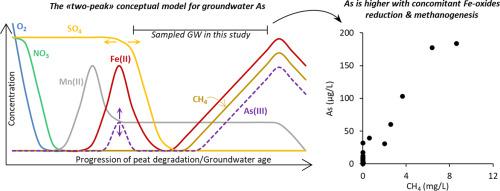Science of the Total Environment ( IF 8.2 ) Pub Date : 2020-11-21 , DOI: 10.1016/j.scitotenv.2020.143646 Marco Rotiroti , Tullia Bonomi , Elisa Sacchi , John M. McArthur , Rasmus Jakobsen , Alessandra Sciarra , Giuseppe Etiope , Chiara Zanotti , Veronica Nava , Letizia Fumagalli , Barbara Leoni

|
Understanding the factors that control As concentrations in groundwater is vital for supplying safe groundwater in regions with As-polluted aquifers. Despite much research, mainly addressing Holocene aquifers hosting young (<100 yrs) groundwater, the source, transport, and fate of As in Pleistocene aquifers with fossil (>12,000 yrs) groundwaters are not yet fully understood and so are assessed here through an evaluation of the redox properties of the system in a type locality, the Po Plain (Italy).
Analyses of redox-sensitive species and major ions on 22 groundwater samples from the Pleistocene arsenic-affected aquifer in the Po Plain shows that groundwater concentrations of As are controlled by the simultaneous operation of several terminal electron accepters. Organic matter, present as peat, is abundant in the aquifer, allowing groundwater to reach a quasi-steady-state of highly reducing conditions close to thermodynamic equilibrium. In this system, simultaneous reduction of Fe-oxide and sulfate results in low concentrations of As (median 7 μg/L) whereas As reaches higher concentrations (median of 82 μg/L) during simultaneous methanogenesis and Fe-reduction. The position of well-screens is an additional controlling factor on groundwater As: short screens that overlap confining aquitards generate higher As concentrations than long screens placed away from them. A conceptual model for groundwater As, applicable worldwide in other Pleistocene aquifers with reducible Fe-oxides and abundant organic matter is proposed: As may have two concentration peaks, the first after prolonged Fe-oxide reduction and until sulfate reduction takes place, the second during simultaneous Fe-reduction and methanogenesis.
中文翻译:

重叠的氧化还原区控制了更新世的多层多层含水层中的砷污染,意大利普平原
了解控制地下水中As浓度的因素对于为As污染的含水层提供安全的地下水至关重要。尽管进行了大量研究,但主要针对的是容纳年轻(<100年)地下水的全新世含水层,但尚未完全了解更新世含水层中化石(> 12,000年)地下水中As的来源,运输和结局,因此在此通过评估进行评估类型区域(Po平原(意大利))中系统的氧化还原特性。
对从波新平原受更新世砷影响的含水层中的22个地下水样品中的氧化还原敏感物质和主要离子的分析表明,砷的地下水浓度受几个末端电子受体的同时运行控制。以泥炭形式存在的有机物在含水层中非常丰富,使地下水达到了接近热力学平衡的高度还原条件的准稳态。在该系统中,同时还原铁氧化物和硫酸盐会导致低浓度的砷(中位值为7μg/ L),而在甲烷化和铁还原的同时,砷达到较高的浓度(中位值为82μg/ L)。滤网的位置是对地下水的另一个控制因素。与密闭的a鱼重叠的短筛比远离它们的长筛产生更高的As浓度。提出了一种地下水As的概念模型,该模型在世界范围内适用于其他具有可还原的Fe-氧化物和丰富的有机质的更新世含水层:由于可能具有两个浓度峰值,第一个是长时间还原Fe-氧化物后直到硫酸盐还原,第二个是在同时还原铁和甲烷生成。











































 京公网安备 11010802027423号
京公网安备 11010802027423号